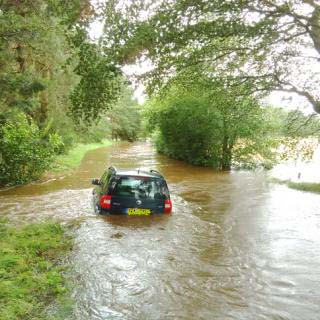
After some very dry weather to start Autumn, November is turning out rather wet and flood incidents are on the rise.

Why would you drive through a flood?
Well, because you think it will be okay, not that bad, bit of a puddle. I used to live in NE Scotland and there’s a fair amount of water running off the Grampians especially with snow melt. Filling the rivers, throwing them into spate; when the river rises quickly (and floods) after heavy rain. People salmon fishing watch these episodes carefully. During heavy rain, the aptly named local River Road would generally flood. A local would move the Flood sign out from the hedge and we’d all wait to see how long it would take until someone ignored it and got stranded on the long windy flooded road. (See photo)
We are now heading into winter, the Atlantic is back throwing weather fronts and heavy rain over the UK, day after day and so the flood alerts and warnings are increasing.
If you are driving along a main road and you come across a massive puddle, many of us gingerly drive through, remembering our Highway Code from the Driving test. As I thought Keep accelerating steadily, otherwise the water will go up the exhaust pipe and your engine will stop.
Aquaplaning is a problem -driving too fast through standing water could lead to tyres losing contact with the road. To regain grip, ease off the accelerator, do not brake and allow your speed to reduce until you gain full control of the steering again. Also don't drive in heavy rain with your cruise control on.
What adds to the danger is flowing water, with hidden branches and debris, and just how strong that current will be as the waters get deeper. And also where the road actually is, you don’t want to drift off the tarmac on the River Road. For pedestrians, six inches of fast flowing water will knock you over and two feet of water will float your car. Not only does the height of the road change, the flow of the waters can increase very quickly. Underestimating the power and force of flood waters is the main cause of flood deaths. In the US, they use "TADD", Turn around, Don’t Drown, which highlights how many people do continue as they think, ‘eek, I’ve come this far it must get better in a moment’, rather than trying a manoeuvre.
Some local roads do just flood, with long shallow sections of standing water. For these it is worth letting the person in front get through and clear in case they do have to stop. Also driving steadily and slowly avoids a bow wave pushing out ahead, being considerate to others helps, 4x4 drivers.
If you do end up stranded in a flood, the advice is not to try to re-start your engine. It is likely that your car could suffer catastrophic engine failure and no-one wants to have to shell out for a new engine. Also anyone who has had their car stolen will know, it’s not just the car, it is losing all the belongings, car seats etc. which will be ruined. In this age of mobile phones, calling for help is easier, unless you are in a rural low level setting (by a river) with ropey coverage. However, Sat Nav should not be followed blindly, as it doesn’t know how road conditions, say across a Ford, will have changed with the weather.
As always keep an eye on the weather forecasts, the warnings are closely linked to the Environment agency warnings now. For more detail about specific areas use the Flood maps from SEPA and the Environment Agency
Old driving test Question - What must you always do when you have driven through a flood?